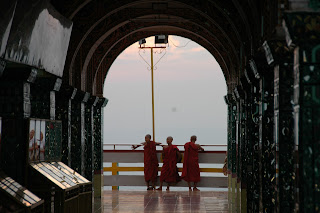Travelling in Mandalay is a slow business,
however with all the activity 40 kph seemed quite fast on many occasions. You
never know what the mix of vehicles and animals may be at any moment. (The road
to the airport was the exception with motorway style roadway once out of town
and virtually no traffic. The only drawback was the culverts every 200 metres had
all subsided which required slowing to 20 kph. Just short of the airport the
road changed to 2 way and we realised the motorway went onto an army barracks –
so it was not built for travellers in any case!)
One
of the last pagodas we visited was The Golden Palace Monastery. It was
appropriately named.
Here visitors spent much of their hard
earned money on gold leaf and then sticking this on the Buddha.
In the evening we visited the pagoda at the
top of Mandalay Hill behind the hotel. The view was extraordinary. At the
middle right can be seen part of the 50 metre wide and 1.5 kms square canal
surrounding the Mandalay palace.
Mind you the local monks seemed to be more
enjoying each other’s company and the ambiance of the pagoda than any view.
As it got dark we had to make our way down
to the chaotic taxi “rank” which preceded a rather breath-taking descent as we
bounced around the back of the truck while the driver tried to work out which
was the brake pedal.
Safely at the bottom we enjoyed the calm of
the spectacular pool area to the hotel which was overlooked by the pagoda.
Somewhat decadent but the peace was appreciated.
The following day we had an additional stop
(at the request of Martin) at the main railway station. Flying may be risky but
I suspect it is less hazardous and more predictable than the train. It was
packed with people fast asleep in the carriages waiting for something to happen
(which wasn’t going to be any time soon as there was not a loco to be seen
anywhere). Maintenance issues were readily resolved by just removing the
offending part hence the escalators were without treads.
The extent of the use of manual labour was
underpinned by the making of gold leaf. This is an extraordinary process with a
small piece of gold hammered many times between sheets of a bamboo paper which in turn take 3
years to make. The hammers are pretty heavy. What a way to earn a living – just
above breaking rocks. At least they had a constant flow of visitors.
Some of the other manual work was far more
creative. We visited one furniture maker that specialised in carving.
Outside I was struck by the artistry in
modelling a large piece of driftwood.
The closer you looked the more details became apparent
including dragons, snakes and deer. Months of work.
During one of our pagoda visits a painter
was rapidly producing pictures using black paint, a couple of brushes and a
razor blade. Most pictures were done in a couple of minutes. Very skilled and
cheap, however our house is officially out of wall space.
Further down the road was a silver
merchant. Here stories are being hammered onto a silver bowl which has been
filled temporarily with pitch so the bowel does not get knocked out of shape.
The bellows were quite crude (and who knows
how old) with the operator pumping the bellows while working the silverware
(here braising on the bottom of a pot).
Our final afternoon was spent travelling to the old capital city of Ava. We travelled by a noisy long tail boat.
Once across we had some lunch and then
travelled by pony trap to a variety of pagodas. (Not for us the distinctly more modern motor vehicles seen here overtaking.)
Some of the pagodas in this region were very old. The later roof addition to this structure tried to redefine vertical but is slowly succumbing to the lean of its supporting tower (Burma can easily out compete Pisa).
The Royal Palace and fort was very
elaborate albeit in need of some TLC. It also appeared to have suffered some
damage from the recent earthquake.
The adjoining pagoda in the background was by comparison
better maintained.
This was our last day in Burma and the next
day we headed for our long flights back.
A wonderful trip which we would recommend to anyone – go for the Pandaw
cruise rather than any other as there is more authenticity in the vessel to
Burma’s past. We with Sue and Martin have committed to now undertaking a
similar cruise on the Mekong in Vietnam. (The only issue is when!) The standout
memories were the great friendliness of the people, “shoes off please” and those wonderful sunsets.










